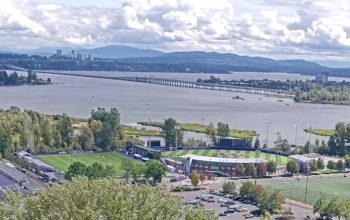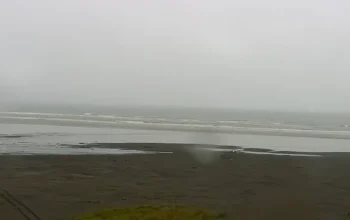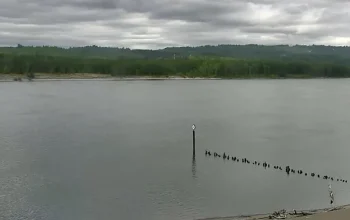Check the Hurricane Ridge Webcam Before You Go
Before heading up the mountain, it’s smart to check the Hurricane Ridge Webcam. This real-time feed gives you a live view of weather conditions at the ridge. You can see how clear the skies are, how much snow is on the ground, and whether the road looks safe to travel. This webcam is especially useful during winter months when snowstorms and low visibility can affect access. By checking the webcam, you can plan your trip more effectively and avoid any surprises. It also helps photographers and nature lovers decide the best time to visit. The Hurricane Ridge Camera is updated regularly and is available online through the National Park Service or partner sites. For anyone looking to hike, ski, or sightsee at Hurricane Ridge, the webcam is an essential tool for trip planning. It’s always better to be prepared, and the webcam helps you get a live view of this gateway into Olympic National Park.
Things to Do on Hurricane Ridge: Outdoor Fun and Adventure
Hurricane Ridge, located in the heart of Olympic National Park in Washington State, is a destination packed with adventure. Sitting nearly a mile above sea level, this stunning spot offers breathtaking views, incredible trails, and year-round activities for nature lovers, hikers, and winter sports enthusiasts.
Start at the Hurricane Ridge Visitor Center
Before setting out on any adventure, make the Hurricane Ridge Visitor Center your first stop. It’s open year-round and provides restrooms, informative exhibits, and an orientation film. During the summer and weekends from late December through March, the visitor center is staffed to help with questions and information. A gift shop and café are open from mid-May to late September, and also on winter weekends. This is the perfect place to grab maps, learn about the area’s history, and ask about trail conditions or upcoming ranger-led programs.
Hike the Scenic Trails
Hurricane Ridge is a hiker’s paradise, especially in the summer months. You’ll find trails for all skill levels, from easy paved walks to challenging alpine treks.
Hurricane Hill Trail
One of the most popular trails is the Hurricane Hill Trail. On a clear day, hikers enjoy sweeping 360-degree views. Look north across the Strait of Juan de Fuca to Victoria, Canada, or south to Mount Olympus and its glaciers. The trail winds through subalpine meadows dotted with wildflowers such as avalanche lilies, lupine, and Indian Paintbrush. Marmots are common along the trail. You might hear their signature whistle before you see them. Whistling back often gets a response!
Sunrise and Sunset Views
Morning and evening hikes offer a special kind of beauty. The light casts long shadows over the peaks and paints the sky with bold colors. Sunrise hikes are quieter and offer a peaceful experience, while sunset walks provide a warm glow over the landscape.
Short Walks and Accessible Paths
Not every hike has to be a challenge. There are several shorter, paved trails near the visitor center, perfect for families with young kids or anyone looking for an easier stroll. These paths still provide amazing views and are a great way to enjoy the natural beauty without the effort of a longer hike.
Enjoy a Summer Picnic
During the summer, Picnic Areas A and B are open and located just a mile beyond the visitor center. These spots have water, restrooms, and paved paths to picnic tables. Bring your own lunch and enjoy your meal surrounded by mountain views and fresh air. In the winter months, visitors can eat upstairs inside the visitor center.
Visit in Winter for Snow Sports and Scenic Vistas
When snow covers the ridge, Hurricane Ridge transforms into a winter playground. The area boasts one of the most scenic snow-covered landscapes in the Pacific Northwest.
Hurricane Ridge Ski and Snowboard Area
At an elevation of 5,240 feet, this family-friendly ski and snowboard area is ideal for beginners and experienced riders. There are two rope tows, a Poma lift, and a dedicated tubing park. The area receives over 400 inches of snow annually. The ski season typically runs from mid-December through March, depending on weather conditions. It’s a small resort, but its charm lies in its peaceful setting and close-knit feel.
Skiing and Snowboarding Lessons
The Hurricane Ridge Winter Sports Club offers lessons for ages four and up. Private lessons are also available. Whether you’re learning the basics or refining your technique, skilled instructors make it fun and safe.
Snowshoeing Adventures
Snowshoeing is another great way to explore the ridge during winter. Easy meadows near the visitor center are perfect for beginners, while the backcountry offers challenges for experienced snowshoers. Ranger-led snowshoe walks are held on Saturdays through March, snow permitting. These walks are under a mile and last about 90 minutes. Only snowshoes are provided, and space is limited to 25 participants per walk. Sign up starts 30 minutes before the walk at the visitor center desk.
Safety Tips for Winter Explorers
Although Hurricane Ridge is relatively close to town, winter weather can be harsh. Whiteouts, avalanches, and sudden storms are common. If you plan to venture beyond marked areas, you must register at the visitor center and carry proper gear. Always check the road and weather conditions before heading up. The road to Hurricane Ridge is usually open 24 hours from mid-May to October, and on weekends during the rest of the year. For updates, call 360-565-3131.
Slide into Fun at the Tubing Park
The tubing park at Hurricane Ridge adds another level of fun, especially for families. Only visitors nine years or older can use this park, and sliding is only allowed using tubes provided by the ski area. The park is open on select days and is subject to weather conditions. For updates and rules, visit hurricaneridge.com.
Photography and Wildlife Watching
Beyond skiing and hiking, Hurricane Ridge is a dream spot for photographers and wildlife watchers. The landscape shifts dramatically with the seasons, providing endless photo opportunities.
Capture the Beauty
In summer, bright meadows filled with wildflowers contrast against the jagged peaks. In winter, snow-covered trees and foggy ridges create a magical scene. Sunrise and sunset are the best times for dramatic lighting and fewer crowds.
Look for Wildlife
Aside from marmots, you might spot deer, black bears (in summer), and a variety of birds. Always observe wildlife from a safe distance and never feed animals. Keep your camera ready—you never know what you’ll see!
Plan Your Trip to Hurricane Ridge
Whether you’re visiting for a day or spending a weekend, planning ahead makes your trip smoother and safer.
What to Bring
- Sturdy shoes for hiking
- Layers for changing weather
- Sunscreen and sunglasses
- Plenty of water and snacks
- Camera or binoculars
- Snow gear in winter
Check Road and Weather Conditions
Before you head up the ridge, call the 24-hour info line at 360-565-3131. Roads may close due to snow or storms, especially in the winter.
Respect Nature and Park Rules
Stay on trails, pack out your trash, and respect wildlife. Leave no trace so Hurricane Ridge can stay beautiful for years to come.
Something for Every Season
No matter the time of year, Hurricane Ridge offers something unforgettable. Summer means wildflowers, hiking, and picnics under the sun. Winter brings powdery snow, tubing, and cozy lodge moments.
Hurricane Ridge is more than just a scenic drive. It’s a place where outdoor dreams come to life—where every trail leads to beauty, and every snowflake opens the door to adventure. Whether you’re hiking the hills in summer or skiing through fresh snow in winter, Hurricane Ridge is your gateway to the wild wonders of Olympic National Park.
History of Hurricane Ridge and Olympic National Park
The First Peoples of the Olympic Peninsula
Long before Hurricane Ridge drew skiers and hikers, the land was home to Native communities. The Makah, Quileute, Hoh, Quinault, Skokomish, Port Gamble S’Klallam, Jamestown S’Klallam, and Lower Elwha Klallam people have lived in this region since time immemorial. Their lives were—and still are—deeply tied to the forests, rivers, mountains, and coastline.
These groups depended on the land for food, shelter, medicine, and spiritual connection. Their knowledge of the environment shaped how they fished, hunted, and gathered. Seasonal movements allowed them to use different parts of the landscape year-round. These communities still maintain strong cultural ties to the land, offering vital insights into its history and ecology.
European Exploration and Settlement of Olympic Peninsula
In the 1800s, European settlers began arriving on the Olympic Peninsula. They brought new industries like logging, fishing, and mining. Exploration teams ventured deep into the interior. Among the most notable was Lieutenant Joseph O’Neil, who led a key expedition in 1890.
Naturalist John Muir and Washington Congressman James Wickersham also visited and saw the value in preserving this wild land. They helped spark interest in protecting the area before widespread development took hold. The Elwha Valley, close to what would become Hurricane Ridge, played a major role in early settlement and exploration.
Early Preservation Efforts and National Recognition
In response to growing concerns over deforestation, President Grover Cleveland declared the area a Forest Reserve in 1897. This marked the first federal step toward protecting the land.
Then, in 1909, President Theodore Roosevelt designated part of the forest as Mount Olympus National Monument. He acted to protect the Roosevelt Elk, a species facing extinction due to overhunting and habitat loss. These elk, named after the president himself, became a powerful symbol of conservation.
As more visitors and naturalists explored the area, public support for stronger protections grew. By 1937, President Franklin D. Roosevelt toured the Olympic Peninsula. After seeing its beauty firsthand, he supported the idea of a national park. Just a year later, in 1938, Congress passed the act that created Olympic National Park. In 1953, an additional stretch of Pacific coastline was added, expanding the park’s unique mix of mountain, forest, and marine environments.
Hurricane Ridge Lodge and Road: The 1950s Expansion
The 1950s saw major developments at Hurricane Ridge, aimed at making it more accessible to visitors. Fred Overly, the park’s second superintendent, led efforts to increase tourism. His vision included building a road and a lodge at the ridge.
Construction on Hurricane Ridge Road took eight years. Finally, on January 1, 1958, the road opened to vehicles. Just a few years earlier, in 1952, Congressman Henry M. Jackson had dedicated the Hurricane Ridge Day Lodge. This facility became a central hub for visitors, offering food, rest, and information.
These projects were part of the larger Mission 66 program, a national initiative to improve park infrastructure by the National Park Service’s 50th anniversary. The road and lodge made Hurricane Ridge a year-round destination, especially for those who couldn’t explore the park’s backcountry on foot.
The Rise and Challenges of Winter Sports
In the same era, Hurricane Ridge became a focal point for winter recreation. Skiing had earlier taken place at Deer Park, but officials saw Hurricane Ridge as a better long-term option. A new day lodge opened in 1952, and the paved road that followed made the area easier to reach in winter.
As the years passed, skiing and snowboarding remained popular. However, national sentiment toward skiing in national parks began to shift. Critics argued that ski resorts clashed with conservation goals. Despite this, the Hurricane Ridge Ski and Snowboard Area continued operations with a small, family-friendly focus.
In the late 1990s, budget and safety concerns led the park to restrict winter access. Initially, access was cut to weekends only. By 2005, it was limited to Friday through Sunday. Locals rallied to restore full winter access, raising $75,000 to cover operational gaps. The park ran a trial period in 2011 and 2012, returning to a seven-day schedule. Although winter visitation jumped 35%, the trial ended, and weekend-only access resumed.
Tragedy and Transition: The 2023 Fire
A turning point came on May 7, 2023. During renovation work, a fire broke out and destroyed the Hurricane Ridge Day Lodge. Built in 1952, the lodge had served generations of visitors. It had evolved from a food concession to an educational center focused on wildlife and geology.
Following the fire, the National Park Service closed access to the area. Officials then announced plans to reopen with a new system of timed entry and strict vehicle limits due to reduced facilities. Portable restrooms were added along Hurricane Ridge Road. On June 27, the area reopened to the public with a limit of 315 private vehicles per day. That number rose slightly in July to 345. Long entry lines formed as cars were metered at the park gate. Shuttle services provided by Clallam Transit helped reduce traffic and continued operating.
International Honors and Ongoing Preservation
Olympic National Park’s value goes far beyond its borders. In 1976, UNESCO designated it as an International Biosphere Reserve. This status highlights the park’s importance in global conservation efforts.
In 1981, it gained even higher recognition as a World Heritage Site. That placed it among the world’s most treasured natural places. The park’s unique blend of ecosystems—from glacier-topped mountains to ancient temperate rainforests—makes it a rare jewel on Earth.
Within the park boundaries, more than 650 archaeological sites have been recorded. These sites trace back over 12,000 years, offering glimpses into ancient human life. Historic buildings and old homesteads also reveal the struggles and achievements of early settlers in the Pacific Northwest.
Looking Ahead: A Legacy of Stewardship
Today, Hurricane Ridge stands as a symbol of resilience and renewal. The destruction of the lodge was a major loss, but it also opened the door for a fresh start. The National Park Service continues working with local communities, tribal nations, and conservation groups to rebuild and reimagine visitor access.
Preservation remains a top priority. The lessons of the past—both triumphs and setbacks—guide how the park is managed today. From indigenous stewardship to federal protections, from ski lifts to shuttle buses, Hurricane Ridge reflects the evolving story of people and nature in the Pacific Northwest.
By protecting this land, we honor not just its scenic beauty, but the cultures, communities, and species that call it home.



